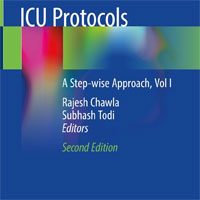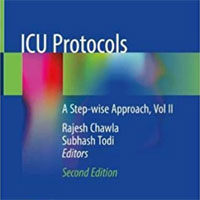Tag: hypoxemia
ARDS vs. PseudoARDS – Failure of the Berlin Definition
True ARDS might be defined as a histological diagnosis involving diffuse alveolar damage throughout the lungs (characterized by hyaline membrane formation and thickening of the alveolar walls). PseudoARDS refers to patients... read more
Dexamethasone 12 mg vs. 6 mg for COVID-19 Patients with Severe Hypoxia
Among patients with COVID-19 and severe hypoxia, dexamethasone 12 mg did not result in statistically significantly more days alive without life support at 28 days than dexamethasone 6 mg. However, the confidence interval... read more
A Rational Approach on the use of ECMO in Severe Hypoxemia
Veno-venous extracorporeal membrane oxygenation (ECMO) is a helpful intervention in patients with severe refractory hypoxemia either because mechanical ventilation cannot ensure adequate oxygenation or because lung protective... read more
Breath-holding as a Novel Approach to COVID-19 Risk Stratification
Despite considerable progress, it remains unclear why some patients admitted for COVID-19 develop adverse outcomes while others recover spontaneously. Clues may lie with the predisposition to hypoxemia or unexpected absence... read more
Severity of Hypoxemia may Explain Indeterminate Results in Pediatric Trials of iNO
Inhaled nitric oxide (iNO) is used for refractory hypoxemia in acute respiratory distress syndrome (ARDS) via vasodilation of pulmonary arterioles to ventilated alveoli, particularly in pediatrics. However, iNO has not affected... read more
NIV After Early Extubation Reduces Total Days Spent on i-MV
Patients recovering from an episode of hypoxemic acute respiratory failure (hARF) may benefit from a weaning strategy based on early extubation followed by immediate noninvasive ventilation (NIV) application. Compared... read more
New Therapy Could Protect Lung Function in COVID-19 Patients
There is an urgent need for new drugs for ARDS patients, including those with COVID-19. ARDS in influenza-infected mice is associated with reduced levels of liponucleotides (essential precursors for de novo phospholipid synthesis)... read more
Prone Positioning of Nonintubated Patients with COVID-19
Despite the significant variability in frequency and duration of prone positioning and respiratory supports applied, prone positioning was associated with improvement in oxygenation variables without any reported serious... read more
Effect of Helmet Noninvasive Ventilation vs. High-Flow Nasal Oxygen in Patients with COVID-19
Among patients with COVID-19 and moderate to severe hypoxemia, treatment with helmet noninvasive ventilation, compared with high-flow nasal oxygen, resulted in no significant difference in the number of days free of respiratory... read more
Intubation Practices and Adverse Peri-intubation Events in Critically Ill Patients
In this observational study of intubation practices in critically ill patients from a convenience sample of 197 sites across 29 countries, major adverse peri-intubation events—in particular cardiovascular instability—were... read more
Balanced Opioid-free Anesthesia with Dexmedetomidine vs. Balanced Anesthesia with Remifentanil for Noncardiac Surgery
This trial refuted the hypothesis that balanced opioid-free anesthesia with dexmedetomidine, compared with remifentanil, would result in fewer postoperative opioid-related adverse events. Conversely, it did result in a greater... read more
High-flow nasal oxygen in patients with COVID-19-associated acute respiratory failure
The use of high-flow nasal oxygen upon ICU admission in adult patients with COVID-19 related acute hypoxemic respiratory failure may lead to an increase in ventilator-free days and a reduction in ICU length of stay, when... read more
Helmet CPAP to treat hypoxic pneumonia outside the ICU
Respiratory failure due to COVID-19 pneumonia is associated with high mortality and may overwhelm health care systems, due to the surge of patients requiring advanced respiratory support. Shortage of intensive care unit... read more
Prone Positioning Non-intubated COVID-19 Patients with Severe Hypoxemia Was Safe
In a small sample, prone positioning non-intubated COVID-19 patients with severe hypoxemia was safe; however, many patients did not tolerate prolonged durations. Although patients had improved oxygenation and respiratory... read more
Pre-hospital critical care management of severe hypoxemia in victims of COVID-19
Patients with Covid-19 and severe hypoxemia may pose a considerable challenge for the pre-hospital emergency medical services. Intubation may be associated with a high risk of complications in these patients and should be... read more
ECMO for COVID-19 patients in Europe and Israel
As of October 17th the novel coronavirus (SARS-CoV-2) caused a pandemic disease (coronavirus disease 2019, COVID-19) 40 million people worldwide, with almost one million deaths. Although most patients have an uncomplicated... read more
Transfusion Associated Circulatory Overload
A 67-year-old female with a history of congestive heart failure and CKD was brought in by ambulance from her nursing home for a gastrointestinal bleed. The patient’s total fluid balance from her nursing home was 2.5L over... read more
Clinical characteristics of critically ill patients with COVID-19
In this study of critical patients infected by SARS-CoV-2 in a high-complexity hospital, the majority were comorbid elderly men, a large percentage required invasive mechanical ventilation, and ICU mortality was 25%. Design... read more
COVID-19 and ARDS: The Baby Lung Size Matters
COVID-19 in its initial manifestations has strikingly peculiar characteristics (e.g., hypoxemia with vasocentric injury and high gas lung volume), is so evident that atypical ARDS should not be a matter of further discussion.... read more
Increased Dead Space Ventilation and Refractory Hypercapnia in Patients with COVID-19
We speculate that thromboinflammation with pulmonary microvasculature occlusion leads to a sudden increase in dead space and shunt resulting in severe hypercapnia and hypoxemia in coronavirus disease 2019 patients. Early... read more
Utility of RV Remodeling Over Risk Stratification in COVID-19
This study contributes to the growing body of literature illustrating the adverse prognostic implications of RV dilation and dysfunction in the setting of severe COVID-19. Mechanistic explanations for RV failure in this population... read more
Lung Histopathology in COVID-19 as Compared to SARS and H1N1 Influenza
Diffuse alveolar damage (DAD) was reported in 88% of patients with COVID-19. This is similar to both H1N1 (90%) and SARS (98%). Pulmonary microthrombi was reported in 57% of patients with COVID-19. This was similar to... read more









